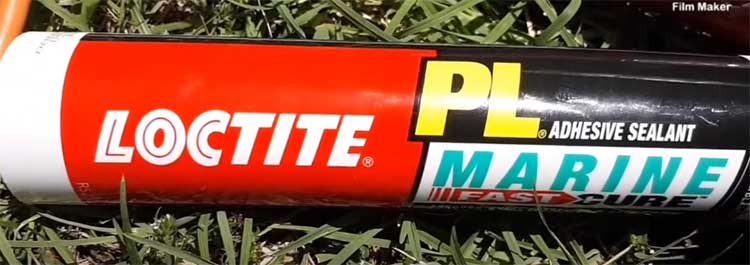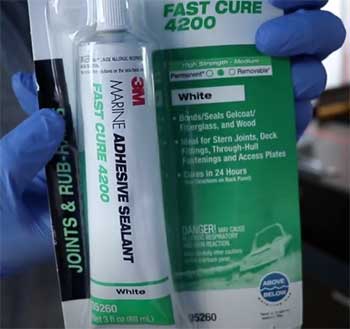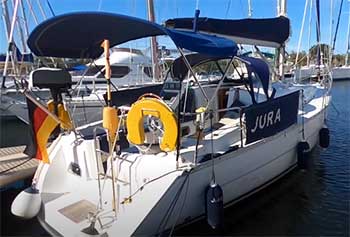In the world of marine adhesives, two contenders stand out from the crowd—Loctite PL Marine and 3M 4200.
Both of these high-performing adhesives are used in a wide range of applications, but which one should you choose for your boat maintenance or repair needs?
A Brief Comparison Table
Here’s a comparison table to better visualize the key differences between these two products:
| Feature | Loctite PL Marine | 3M 4200 |
| Curing Time | Fast (24 hours) | Slower (Up to 48 hours) |
| Flexibility | Good | Excellent |
| Removability | More difficult (Permanent bond) | Easier (Semi-permanent bond) |
| Environmental Impact | Less (Solvent-free) | More (Contains solvents) |
| Use | Above and below waterline | Above and below waterline |
| Ideal Application | Quick repairs, permanent bonding | High vibration areas, temporary fixes |
Loctite PL Marine: The Reliable Choice

Loctite PL Marine Fast Cure Adhesive Sealant is designed specifically for marine environments, offering high adhesive strength and flexibility.
A key feature of this adhesive is its fast cure time, setting in just 20 minutes and fully curing in 24 hours. It’s an excellent choice for quick and efficient boat repairs.
Pros of Loctite PL Marine
- Fast Curing: For those in need of quick solutions, Loctite PL Marine takes the lead. This adhesive takes less time to cure compared to other marine adhesives, making it the ideal choice for on-the-spot repairs.
- Superior Adhesion: Whether it’s wood, fiberglass, or metal, Loctite PL Marine bonds strongly to a variety of surfaces, ensuring a durable and long-lasting seal.
- Environmentally Friendly: Loctite PL Marine is free from solvents, which means it’s less harmful to the environment than some of its competitors.
Cons of Loctite PL Marine
- Not as Flexible: While it’s a reliable choice for many applications, Loctite PL Marine may not provide the same level of flexibility as some other adhesives, which can limit its effectiveness in certain situations.
3M 4200: The Versatile Performer
3M 4200 Fast Cure Adhesive Sealant is a well-rounded adhesive with excellent adhesion and flexibility properties. Known for its toughness, this medium-strength adhesive is suitable for both above and below the waterline applications.
Pros of 3M 4200
- Excellent Flexibility: 3M 4200 excels when it comes to flexibility. This makes it a great choice for applications where movement and vibration are common, such as deck fittings.
- Strong and Durable: This adhesive provides a reliable and robust seal, which can withstand various harsh conditions commonly encountered in marine environments.
- Easy to Remove: Unlike many other adhesives, 3M 4200 can be removed without causing damage, making it a preferable option for temporary fixes.
Cons of 3M 4200
- Slower Curing: Although it offers other significant advantages, 3M 4200 can take longer to cure compared to Loctite PL Marine, which could be a potential downside for time-sensitive projects.
Key Differences Between Loctite PL Marine and 3M 4200 Adhesive
While both Loctite PL Marine and 3M 4200 are popular adhesive choices for marine applications, they have distinct differences that could make one a better fit for your needs over the other. Understanding these differences can help you make an informed decision.
- Curing Time

The curing time of an adhesive can significantly impact the speed and ease of your repair or maintenance project.
In this regard, Loctite PL Marine stands out.
Its fast curing formulation sets in 20 minutes and fully cures within 24 hours, making it ideal for quick repairs and projects.
In contrast, 3M 4200 requires a more extended period to cure.
Although its curing time is dependent on temperature, humidity, and the type of materials being bonded, it generally takes up to 48 hours to fully cure.
This slower curing time might not be an issue for planned maintenance work but could be inconvenient for emergency repairs.
- Flexibility
Flexibility is another significant factor when considering an adhesive for marine applications. A more flexible sealant can accommodate movement and vibration better, especially in above the waterline applications such as deck fittings.
In terms of flexibility, 3M 4200 takes the cake. Its formulation provides excellent flexibility, making it the perfect choice for areas exposed to a lot of movement and vibration.
On the other hand, Loctite PL Marine, although providing good flexibility, might not perform as well as 3M 4200 in high-vibration applications.
- Removability
When it comes to removability, 3M 4200 stands out. This semi-permanent adhesive can be removed without causing damage, which makes it ideal for temporary fixes or areas where you might need to disassemble components in the future.
On the contrary, Loctite PL Marine, once cured, forms a more permanent bond, which can be more challenging to remove. While this means that it provides a long-lasting seal, it may not be the best choice for applications that require future disassembly.
- Environmental Consideration
Loctite PL Marine takes a slight edge in environmental considerations. It is free from solvents, which makes it less harmful to the environment. Although 3M 4200 isn’t notably detrimental to the environment, it is a point worth considering for eco-conscious users.
Also Read: Comparison of 3M 4200 And 5200 Marine Adhesive Sealants.
Frequently Asked Questions (FAQ)
3M 5200 shares many similarities with 3M 4200. It also offers excellent adhesion and flexibility but is a permanent adhesive, unlike 3M 4200, which is semi-permanent.
For boating applications, Loctite PL Marine Fast Cure is an excellent choice due to its strong adhesion, fast curing time, and marine-specific formulation.
3M 4200 is a versatile marine adhesive suitable for various applications both above and below the waterline. It’s ideal for deck fittings, hull-to-deck seams, and underwater through-hull fittings.
Marine silicone is designed to withstand the harsh conditions of marine environments, including exposure to saltwater and UV rays. Regular silicone may not provide the same level of resistance and longevity in these conditions.
Wrapping It Up
Choosing between Loctite PL Marine and 3M 4200 depends largely on your specific needs. If you’re looking for a quick cure and strong adhesion, Loctite PL Marine is a good bet. On the other hand, if flexibility and easy removal are priorities, 3M 4200 could be the better choice.
In the end, both adhesives have proven themselves as reliable and efficient solutions in the world of marine maintenance and repair.

